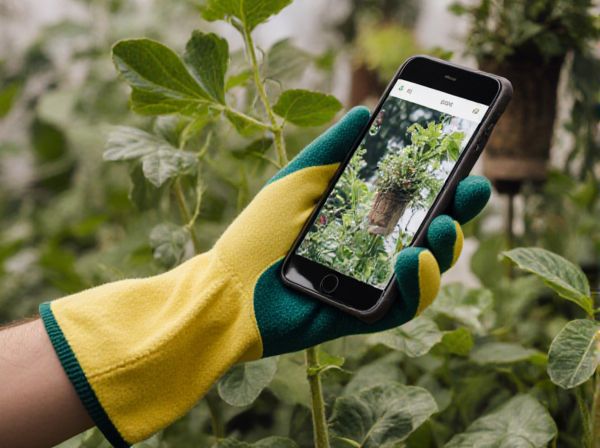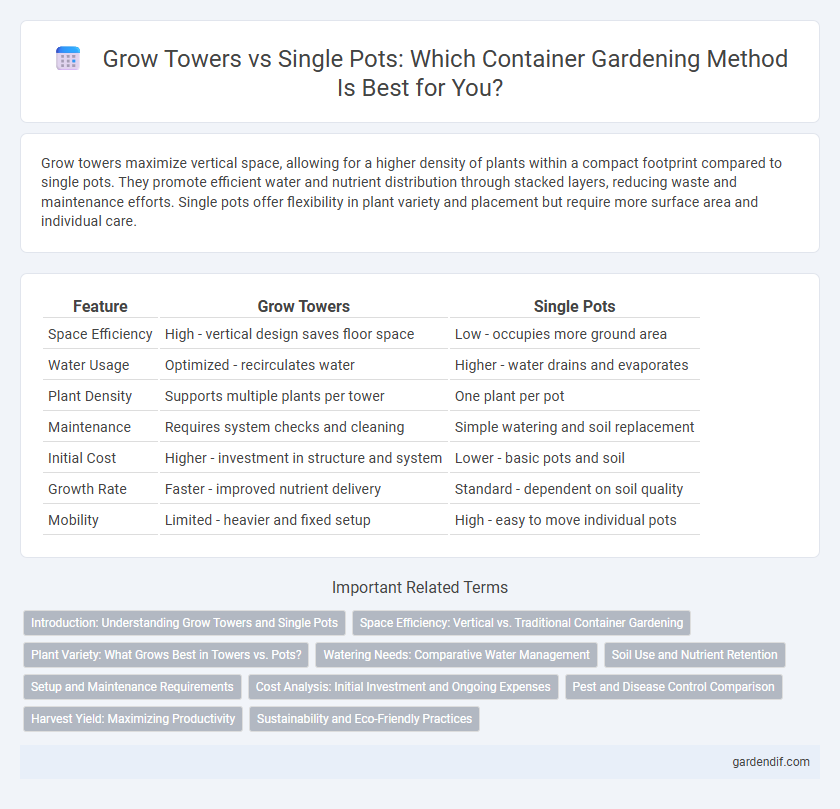
Grow towers vs single pots Illustration
Grow towers maximize vertical space, allowing for a higher density of plants within a compact footprint compared to single pots. They promote efficient water and nutrient distribution through stacked layers, reducing waste and maintenance efforts. Single pots offer flexibility in plant variety and placement but require more surface area and individual care.
Table of Comparison
| Feature | Grow Towers | Single Pots |
|---|---|---|
| Space Efficiency | High - vertical design saves floor space | Low - occupies more ground area |
| Water Usage | Optimized - recirculates water | Higher - water drains and evaporates |
| Plant Density | Supports multiple plants per tower | One plant per pot |
| Maintenance | Requires system checks and cleaning | Simple watering and soil replacement |
| Initial Cost | Higher - investment in structure and system | Lower - basic pots and soil |
| Growth Rate | Faster - improved nutrient delivery | Standard - dependent on soil quality |
| Mobility | Limited - heavier and fixed setup | High - easy to move individual pots |
Introduction: Understanding Grow Towers and Single Pots
Grow towers maximize vertical space by stacking multiple plant containers, offering higher crop density compared to single pots. Single pots provide individual root space and are easier to manage for specific plant needs but require more horizontal space. Understanding these differences helps optimize container gardening based on available area and crop diversity.
Space Efficiency: Vertical vs. Traditional Container Gardening
Grow towers maximize space efficiency by utilizing vertical layers to cultivate multiple plants within a compact footprint, making them ideal for limited areas such as balconies or small patios. Single pots require more horizontal space since each plant grows independently, often leading to a larger overall gardening area. Vertical gardening with grow towers also improves air circulation and sunlight exposure for each plant compared to traditional container setups.
Plant Variety: What Grows Best in Towers vs. Pots?
Grow towers excel in cultivating leafy greens, herbs, and compact vegetables like lettuce, basil, and cherry tomatoes due to their vertical design and efficient space utilization. Single pots, with deeper and wider soil volume, are better suited for larger plants requiring extensive root systems such as peppers, eggplants, and root vegetables like carrots and radishes. Selecting between grow towers and pots depends on the plant variety's root depth, growth habit, and space requirements for optimal yield.
Watering Needs: Comparative Water Management
Grow towers optimize water efficiency by recirculating moisture through a closed system, minimizing waste and reducing watering frequency compared to single pots. Single pots require more frequent watering due to higher evaporation and soil drainage, leading to greater water consumption over time. Advanced drip irrigation integrated in grow towers ensures consistent hydration tailored to each plant's needs, promoting healthier growth with less water usage.
Soil Use and Nutrient Retention
Grow towers maximize soil efficiency by using compact, vertically stacked containers that reduce soil volume while enhancing nutrient absorption through targeted irrigation systems. Single pots often require more soil and experience quicker nutrient leaching due to limited root interaction with the soil matrix. The vertical design of grow towers promotes better moisture retention and nutrient recycling, resulting in healthier plants with less resource waste.
Setup and Maintenance Requirements
Grow towers require a more complex initial setup involving vertical stacking systems and integrated irrigation, while single pots offer simpler, individual containers that are easier to arrange and relocate. Maintenance for grow towers includes monitoring water flow and nutrient distribution throughout multiple levels, whereas single pots demand straightforward watering and occasional soil replacement. Space efficiency favors grow towers, but single pots provide more control over plant-specific care.
Cost Analysis: Initial Investment and Ongoing Expenses
Grow towers offer a lower initial investment compared to single pots due to reduced soil usage and space efficiency, which decreases setup costs. Ongoing expenses for grow towers tend to be lower as they require less water, fertilizer, and maintenance while supporting higher yields per square foot. Single pots may incur higher costs over time due to soil replacement, increased water consumption, and limited plant density.
Pest and Disease Control Comparison
Grow towers minimize pest and disease risks through improved air circulation and vertical spacing, reducing the likelihood of infestations spreading between plants. Single pots often face higher pest pressures due to close proximity and limited airflow, which can create humid conditions favorable for fungal infections. Integrated pest management is more effective in grow towers, allowing targeted application of treatments without affecting neighboring crops.
Harvest Yield: Maximizing Productivity
Grow towers significantly increase harvest yield compared to single pots by utilizing vertical space and enabling more plants per square foot. This design allows for better resource distribution, such as water and nutrients, leading to healthier plants and higher productivity. Optimizing light exposure and airflow in grow towers further enhances growth rates, making them ideal for maximizing harvest output.
Sustainability and Eco-Friendly Practices
Grow towers maximize space efficiency by allowing vertical stacking of plants, reducing the land footprint compared to single pots spread over larger areas. They promote water conservation through recirculating irrigation systems, which significantly decrease runoff and water waste, supporting sustainable gardening. Materials used in many grow towers are often recyclable or biodegradable, enhancing their eco-friendly appeal versus the typically single-use plastics of conventional pots.
Grow towers vs single pots Infographic

 gardendif.com
gardendif.com